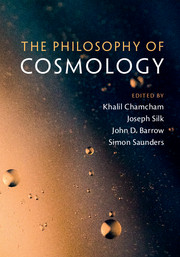Book contents
- Frontmatter
- Contents
- List of Contributors
- Preface
- Acknowledgments
- Part I Issues in the Philosophy of Cosmology
- Part II Structures in the Universe and the Structure of Modern Cosmology
- 5 Some Generalities About Generality
- 6 Emergent Structures of Effective Field Theories
- 7 Cosmological Structure Formation
- 8 Formation of Galaxies
- Part III Foundations of Cosmology: Gravity and the Quantum
- Part IV Quantum Foundations and Quantum Gravity
- Part V Methodological and Philosophical Issues
- Index
- References
7 - Cosmological Structure Formation
from Part II - Structures in the Universe and the Structure of Modern Cosmology
Published online by Cambridge University Press: 18 April 2017
- Frontmatter
- Contents
- List of Contributors
- Preface
- Acknowledgments
- Part I Issues in the Philosophy of Cosmology
- Part II Structures in the Universe and the Structure of Modern Cosmology
- 5 Some Generalities About Generality
- 6 Emergent Structures of Effective Field Theories
- 7 Cosmological Structure Formation
- 8 Formation of Galaxies
- Part III Foundations of Cosmology: Gravity and the Quantum
- Part IV Quantum Foundations and Quantum Gravity
- Part V Methodological and Philosophical Issues
- Index
- References
- Type
- Chapter
- Information
- The Philosophy of Cosmology , pp. 136 - 160Publisher: Cambridge University PressPrint publication year: 2017



